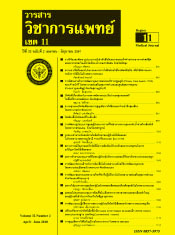Effect and Quality of life after Pessary ring treatment for Pelvic Organ Prolapse
Keywords:
pessary ring, pelvic organ prolapseAbstract
Objective : To prospectively assess the effects of pessary ring and health-related quality of life after treatment
Study design : Prospective descriptive study
Setting : Department of Obstetrics and Gynecology
Methods : 124 women attending gynecological clinic of Phatthalung Hospital from July 2014 to October 2016 with symptom of pelvic organ prolapse who preferred to use a ring pessary were included in this study , all women in this study completed prolapse symptoms questionnaire after used pessary ring 4 months.
Main outcome measures : questionnaire to assess changing of symptom and complacency after pessary ring treatment for 4 months
Results : Out of 124 women recruited to the present study, mean age was 69.34 years,80% successfully retained pessary ring by themself,in a group of success for using 90% feel easy to insert pessary ring by themselves, 90%feel easy to takeout pessary ring by themselves , 88% feel more enjoyment of life and 100% significant improve in symptom of no prolapse coming out of vagina ,92 % significant improve in voiding , 100% significant improve in bowel evacuation ,no significant improve in sexual satisfaction
Conclusion : The pessarey ring treatment is an effective and simple method for alleviating symptoms of pelvic organ prolapse associated pelvic floor dysfunction ,especially improve in awareness of vaginal prolapsed. Failure to retain the pessary is associated with short vaginal length and disability.
References
Cundiff GW, Weidner AC, Visco AG, Bump RC, Addison WA. A survey of pessary use by members of the American Urogynecologic Society. Obstet Gynecol;
2000;95:931–5.
Bai SW, Yoon BS, Kwon JY, Shin JS, Kim SK, Park KH. Survey of the characteristics and satisfaction degree of the patients using a pessary. Int Urogynecol
J Pelvic Floor Dysfunct; 2005;16(3):182–6.
Fernando RJ, Thakar R, Sultan AH, Shah SM, Jones PW. Effect of vaginal pessaries on symptoms associated with pelvic organ prolapse. Obstet Gynecol; 2006; 108(1):93–9.
Hillera L , Radleyb S, Mannc CH , Radleyd SC, Begume G, Development and validation of a questionnaire for the assessment of bowel and lower urinary
tract symptoms in women, BJOG: an International Journal of Obstetrics and Gynaecology;2002;109:413–23.
Clemons JL, Aguilar VC, Tillinghast TA. Risk factors associated with an unsuc-cessful pessary fitting trial in women with pelvic organ prolapse. Am J Obstet
Gynecol; 2004; 190:345-50.
Maito JM, Quam ZA, Craig E, Danner KA, Rogers RG . Predictors of successful pessary fitting and continued use in a nurse-midwifery pessary clinic. J Midwifery
Womens Health; 2006;5(2):78–84.
Irene ML CHEUNG. Use of Vaginal Pessaries for Pelvic Organ Prolapse in Chinese Women , HKJGOM; 2011; 11(1) : 40-8
Sitavarin S, Wattanayingcharoenchai R, Manonai J. The characteristics and satisfaction of the patients using vaginal pessaries. J Med Assoc Thai 2009; 92:744-7.
Alnaif B, Drutz HP. Bacterial vaginosis increases in pessary users. Int Urogy- necol J Pelvic Floor Dysfunct; 2000; 11:219-22.






